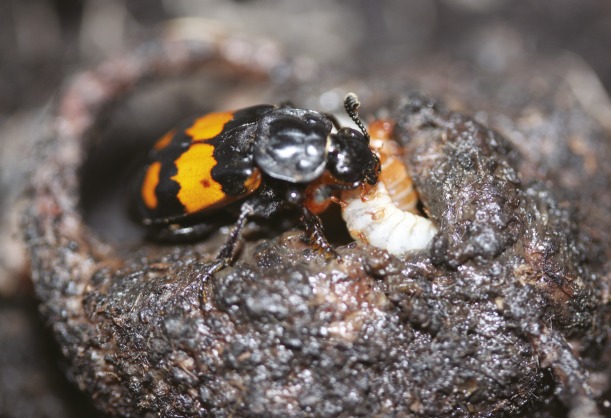Female beetles manipulate males during parental care
Burying beetle.
Male and female parents in many animal species resort to a range of strategies to shift parental duties to each other, minimizing personal workload at the expense of partners. In theory, females can influence offspring growth and behavior through molecular mechanisms triggered during egg production. Hence, Matthieu Paquet and Per Smiseth (pp. 6800–6805) tested whether female burying beetles (Nicrophorus vespilloides) exercise their maternal prerogative to alter prenatal investment in offspring, manipulating males into shouldering a greater proportion of offspring care. Hatchling larvae from lab-reared female beetles that laid eggs when males were present were 3.4% lighter than larvae from females that laid eggs when males were absent, suggesting that females curtail prenatal investment in anticipation of postnatal offspring care from male partners. However, male beetles appeared largely indifferent to the seeming female subterfuge, providing a similar level of offspring care after egg hatching under both conditions. Nonetheless, female manipulation appeared effective in reducing male partners’ consumption of a food source shared with females and offspring during care; males consumed less carrion while caring for broods laid when males were present, potentially allowing such larvae to compensate for their relatively low birth weight. According to the authors, prenatal manipulation by female beetles might influence caregiving male partners’ food consumption. — P.N.
Ubiquitination and neurotoxin-induced paralysis
The botulism neurotoxin BoNT/A blocks neurotransmission by cleaving the SNARE protein SNAP25, resulting in paralysis that can last 2–6 months. Yien Che Tsai et al. (pp. E5158–E5166) report that a deubiquitinating enzyme (DUB) accounts for the prolonged duration of BoNT/A paralysis and might be targeted to mitigate the toxin’s effect. BoNT/A, the authors report, inactivates SNAP25 once it binds to specific receptors on neurons and delivers the catalytic light chain protease into cells. Typically, cells flag foreign proteins for destruction by marking them with ubiquitin through the action of ubiquitin ligase enzymes. However, the BoNT/A light chain remains enzymatically active for months after entering cells. The authors report that the stability reflects the action of the DUB, VCIP135/VCPIP1, which binds the BoNT/A light chain directly, removes ubiquitin, and allows the toxin to evade degradation by the proteasome. Loss of VCIP135 in neurons compromised by BoNT/A promotes the recovery of SNAP25 with no observable toxicity, according to the authors. — T.J.
Estimating the age of Jupiter

View of Jupiter’s south pole created by NASA’s Juno spacecraft. Image courtesy of NASA/JPL-Caltech/SwRI/MSSS/Gabriel Fiset.
Models of gas giant formation predict that Jupiter formed relatively early in the evolution of the Solar System. However, thus far it has not been possible to date the formation of Jupiter. Thomas Kruijer et al. (pp. 6712–6716) inferred the age of Jupiter from the isotopic composition of meteorites. Meteorites can be classified as carbonaceous and noncarbonaceous based on the relative amounts of different molybdenum isotopes, suggesting that the parent bodies of the meteorites from the different groups formed from distinct reservoirs of solar nebula material. The ages of meteorites derived from these two reservoirs, estimated from the relative amounts of tungsten isotopes, indicate that the reservoirs coexisted over an extended period of time beginning approximately 1 million years after Solar System formation. Therefore, the authors reason, the reservoirs must have been spatially separated to prevent intermixing of material. According to the authors, the most plausible mechanism for this separation is the formation of Jupiter, whose large mass would have inhibited transport of solid material across the planet’s orbit. Thus, within 1 million years of the Solar System’s formation, Jupiter had likely grown to 20 times the mass of Earth. The authors suggest that Jupiter’s early formation may have prevented the subsequent formation of “super-Earths” in the Solar System. — B.D.
Socioeconomic status and immune activity during pregnancy

Pregnant woman. Image courtesy of Pixabay/redgular.
Previous research has found that children from economically disadvantaged households are at an increased risk of disease in adulthood. However, how early childhood socioeconomic disadvantages influence health remains unclear. To test whether socioeconomic disadvantage is associated with gestational immune activity and offspring neurodevelopment, Stephen Gilman et al. (pp. 6728–6733) examined the concentrations of five immune markers in largely third-trimester maternal serum in 1,494 women, around 25 years of age, in the New England Family Study. The authors also accounted for the women’s socioeconomic disadvantage and any neurologic abnormalities in offspring. The most socioeconomically disadvantaged women had lower concentrations of the proinflammatory cytokine IL-8 and lower ratios of IL-8 to IL-10, an antiinflammatory cytokine, compared with less disadvantaged women. The children of the most socioeconomically disadvantaged women were more likely to have neurological abnormalities at the ages of 4 months and at 1 year, compared with the children of less disadvantaged women. The association was partly explained by fetal exposure to low levels of maternal IL-8, which was associated with increased risk of neurological abnormalities at the ages of 4 months and 1 year. Levels of the cytokines TNF-α, IL-6, and IL-1β were not associated with socioeconomic disadvantages. According to the authors, gestational maternal immune activity may contribute to the intergenerational transmission of socioeconomic inequalities in health. — L.C.



